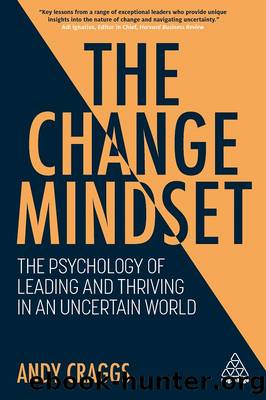The Change Mindset by Craggs Andy;

Author:Craggs, Andy;
Language: eng
Format: epub
Publisher: Kogan Page, Limited
Published: 2022-05-15T00:00:00+00:00
Transition trap 2: Asking for options
The second transition trap I encountered in my conversations was the failure to consider and embrace sufficient alternatives. This is a crucial Change Mindset skill to cultivate and uncover less conventional solutions when faced with complex change. The creative world of performance art and music is the best place I have found to illustrate this phenomenon, starting with the American choreographer Twyla Tharp.
Tharp started dancing in the 1960s in outdoor spaces because she and her young ensemble found it hard to get hired to perform at established indoor venues. A pioneer in both modern dance and ballet, Tharp has enjoyed a long and influential career including collaborations with Film Director Miloš Forman (Hair, Amadeus, Ragtime) and musicians Billy Joel, Frank Sinatra and David Byrne.
In the recent PBS American Masters documentary, Twyla Moves, examples abound of where she found herself caught out by a lack of alternatives and options when faced with change (Cantor, 2021). She speaks about how she had to overcome the challenges of being a young and unknown dancer, without the options available to more established artists. She talks about how she had to create alternatives for herself and her troupe through their style and technique in order to break through. She also reminisces about creating her first unpaid and spontaneous performances in outdoor spaces, on rooftops and even in subway stations to gain initial visibility as an artist. Always asking about what other options might be available, she was ready to perform on any surface and to any audience to gain experience, learning adaptability in the process. âUneven territory was our proving ground,â she says in a vivid metaphor for the importance of adapting to different terrain as leaders of change.
Tharp also says of her early experiences, âYou can learn from anythingâ, referring to how she explored further alternatives by creating a unique ârelaxedâ choreography style that had never been seen before. Because she lacked the typical physique or abilities for pure ballet, she chose to differentiate herself by calling on her own unique gifts and attributes â flexibility, athleticism, and creativity. Rather than trying to imitate other top dancers, she reinvented dance in a way that played to her strengths. âItâs not a question of new steps and styles but of expanding our ordinary movement.â Her speed and creativity led to techniques, which she then adapted to different scenarios to form her unique style. In a vivid example of exploring options, she took on the challenge of writing a choreography piece for Russian dancer Mikhail Baryshnikov in the 1970s. While the public expected a show of classical technique, Tharp chose to completely re-educate him in her new modern style. The reception was outstanding, but her alternative approach took great creativity and courage.
Tharp is also known for other innovations, including forming one of the first all-female ensembles. It was a way to bring the unique strength of each dancer to the fore in a shared group performance. Avoiding traditional male leads in
Download
This site does not store any files on its server. We only index and link to content provided by other sites. Please contact the content providers to delete copyright contents if any and email us, we'll remove relevant links or contents immediately.
Hit Refresh by Satya Nadella(8338)
The Compound Effect by Darren Hardy(7559)
Change Your Questions, Change Your Life by Marilee Adams(6641)
Nudge - Improving Decisions about Health, Wealth, and Happiness by Thaler Sunstein(6633)
The Black Swan by Nassim Nicholas Taleb(6190)
Daring Greatly by Brene Brown(5641)
Deep Work by Cal Newport(5464)
Principles: Life and Work by Ray Dalio(5322)
Rich Dad Poor Dad by Robert T. Kiyosaki(5149)
The Myth of the Strong Leader by Archie Brown(4789)
Man-made Catastrophes and Risk Information Concealment by Dmitry Chernov & Didier Sornette(4736)
Big Magic: Creative Living Beyond Fear by Elizabeth Gilbert(4723)
The Slight Edge by Jeff Olson(4722)
Discipline Equals Freedom by Jocko Willink(4635)
Digital Minimalism by Cal Newport;(4541)
The Motivation Myth by Jeff Haden(4525)
Stone's Rules by Roger Stone(4415)
Management Strategies for the Cloud Revolution: How Cloud Computing Is Transforming Business and Why You Can't Afford to Be Left Behind by Charles Babcock(4131)
The Doodle Revolution by Sunni Brown(4043)
